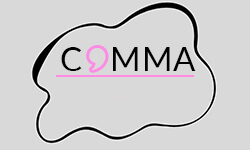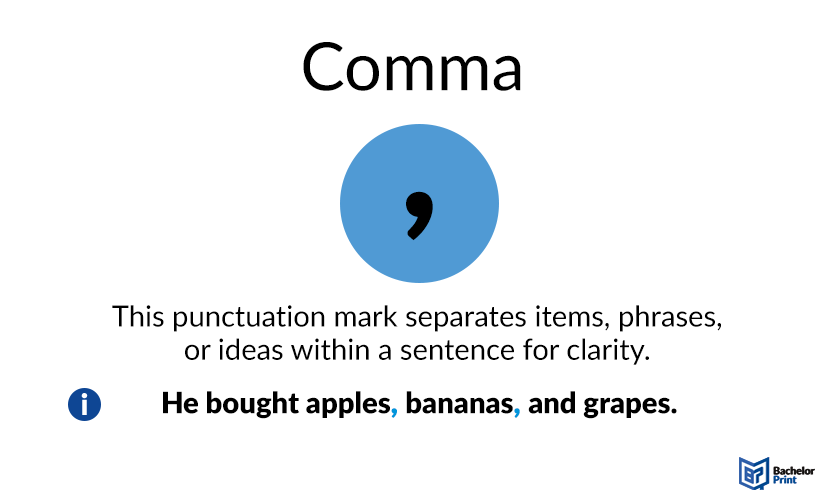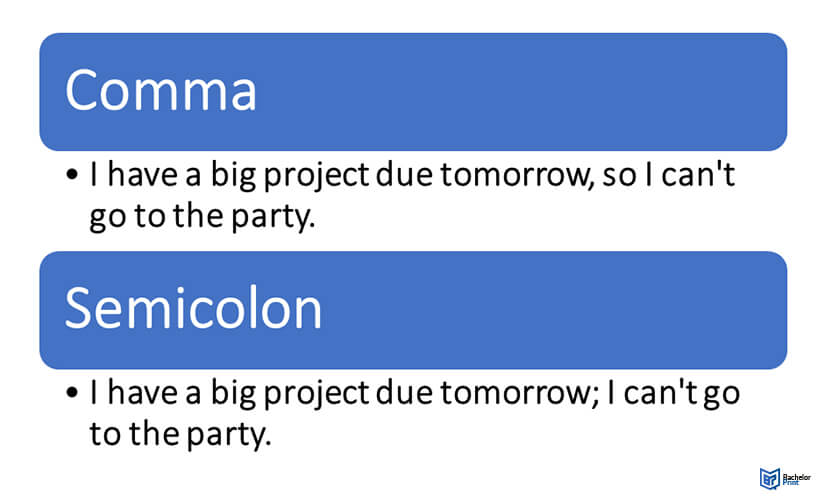
Commas are one of the most misused punctuation marks. They can be confusing to use, especially since their placement often depends on the subtle flow and rhythm of sentences, as well as specific grammatical rules that aren’t always intuitive; however, with a bit of guidance, you’ll be able to use them in your writing correctly. With clear examples and tips, this article will provide all the information you need about commas, from the 15 rules for using them to the mistakes you should avoid.
Definition: Commas
A comma is a punctuation mark most frequently used as a sign of separation in a sentence. It can join independent clauses, separate items in a list, and set off non-restrictive phrases or clauses.
Some of the most common mistakes when using commas include comma splices, using commas to separate elements in compound predicates, and using them to separate the subject from the verb.

Overview of comma rules articles
Printing Your Thesis With BachelorPrint
- High-quality bindings with customizable embossing
- 3D live preview to check your work before ordering
- Free express delivery
Configure your binding now!
What are the rules for using commas?
Commas can be tricky to use, but you can follow some specific rules to ensure you’re using them correctly. Here are 15 rules to guide you:
1. Commas used to separate two independent clauses
Use a comma to separate two independent clauses joined by a coordinating conjunction (for, and, nor, but, or, yet, so). A clause is independent if it can stand alone as a sentence; it has both a subject and a predicate.
2. Commas between items in a series
Use a comma to separate items in a series of three or more items, including the last two. The last comma in a series (before the conjunction) is often called the Oxford comma. While it’s not required, it can help prevent ambiguity.
3. Commas with conjunctive adverbs
Use a comma to separate a conjunctive adverb or phrase from the rest of the sentence. A conjunctive adverb indicates a relationship between ideas in an independent clause, independent clauses in a sentence, or sentences in a paragraph.
4. Commas used to separate a dependent clause at the beginning of a sentence
Use a comma to separate a dependent clause at the beginning of a sentence from the independent clause that follows it. A dependent clause is a clause that can’t stand alone as a sentence because it doesn’t express a complete thought.
5. Commas used to set off non-essential clauses, phrases, or words within a sentence
Use commas to set off non-essential clauses, phrases, or words from the rest of the sentence. These elements are usually not essential to the sentence’s meaning and can be removed without changing the basic grammatical structure.
6. Commas used to set off appositives and interrupters
Use a comma to set off appositives and interrupters from the rest of the sentence. An appositive is a noun or pronoun that renames another noun right next to it. An interrupter is a word, phrase, or clause that interrupts the flow of a sentence.
7. Commas used to separate multiple coordinate adjectives
Use a comma to separate multiple coordinate adjectives that modify the same noun. A coordinate adjective is an adjective equal in rank or degree to another adjective. The sentence will still have the same meaning if the adjectives are used in reverse or if “and” is used between them.
8. Commas used to separate a series of verbs or phrases
Use a comma to separate a series of three or more verbs or phrases when they all refer to the same subject.
9. Commas used to separate tag questions and interjections
Use a comma to separate a tag question or interjection from the rest of the sentence. A tag question is a short question added to the end of a statement to confirm or ask for confirmation of what was said. An interjection is a word or phrase that expresses emotion and is often set off by a comma.
10. Commas used to separate contrasted coordinate elements
Use a comma to separate coordinate elements that provide contrast at the end of a sentence. In other words, if two things are being compared or contrasted, you can use a comma to separate them.
11. Commas to stand in for the omission of duplicated words
Instead of repeating the same word or words in a sentence, you can use a comma as a stand-in. This is also known as an elliptical comma. You can ignore this rule if the sentence becomes difficult to understand due to excess commas.
12. Commas used to introduce a quotation or dialogue
Use a comma to introduce a direct quotation after an introductory clause or phrase. A direct quotation is a word-for-word reproduction of someone else’s speech or writing.
13. Commas used to close a quotation or dialogue
Use a comma to close a quotation or dialogue when an attribution follows it. Attribution refers to a word or phrase that indicates who is speaking.
14. Commas used to indicate direct address
A comma should also be used to indicate direct address, which means that someone is being spoken to directly.
15. Commas used to set off geographical names, titles, and dates
When a sentence includes a date, a geographical name, or a title, you can use commas to set them off from the rest of the sentence.
Commas vs. semicolons
Commas and semicolons can both be used to link two independent clauses. However, a comma can only be used with a coordinating conjunction (for, and, nor, but, yet, so). A semicolon is used when the independent clauses are too closely related to use a period, and no conjunction is present.
Semicolons can also be used to separate items in a list when commas already separate the items to make reading it easier.

What should be avoided when using commas?
Let’s go over a few things you should avoid when using commas:
| ✗ Wrong | ✓ Correct | |
| Avoid splitting subjects from verbs with a comma: | Vivian, is going on vacation. | Vivian is going on vacation. |
| Avoid using a comma before a conjunction if it is followed by a dependent clause: | Scott believes Lydia is kind, and won’t mock him. | Scott believes Lydia is kind and won’t mock him. |
| Avoid using a comma to join two independent clauses if no conjunction is present, also known as a comma splice: | It was raining, he couldn’t walk his dog. | It was raining, so he couldn’t walk his dog. It was raining; he couldn’t walk his dog. |
| Avoid using a comma before and after a list of items: | The astronauts, Neil Armstrong, Buzz Aldrin, and Michael Collins, flew the Apollo 11 mission to the moon. | The astronauts Neil Armstrong, Buzz Aldrin, and Michael Collins flew the Apollo 11 mission to the moon. |
| Avoid using a comma to separate a verb from its direct or indirect object: | The lack of rainfall will affect, farmers. | The lack of rainfall will affect farmers. |
| Avoid using a comma to separate two direct or indirect objects in a sentence with a single verb: | The lovely weather will attract tourists, and locals. | The lovely weather will attract tourists and locals. |
| Avoid using a comma to separate two verbs in a sentence with a single subject: | We will meet at the conference, and network. | We will meet at the conference and network. |
| Avoid using a comma to separate two subjects in a sentence with one verb: | Mike, and Andy, went to the fair. | Mike and Andy went to the fair. |
| Avoid using a comma to separate multiple objects of the same preposition: | She sat between Mike, and Jim. | She sat between Mike and Jim. |
| Avoid using a comma to separate essential information: | David loves seasoning, his food, with cayenne pepper. | David loves seasoning his food with cayenne pepper. |
| Avoid using a comma to separate cumulative adjectives: | Frederick is wearing a red, wool sweater. | Frederick is wearing a red wool sweater. |
| Avoid using a comma to separate a noun from the adjective that modifies it: | He sped away in a yellow, car. | He sped away in a yellow car. |
FAQs
Commas are most commonly used to separate independent clauses, items in a list, and non-restrictive phrases or clauses. They also set off appositives, introductory elements, and direct quotations. Commas are also used to indicate dates, addresses, titles, and numbers.
If you’re unsure whether to use a comma, ask yourself if the element is essential to the sentence’s meaning. Use a comma when omitting words from a quoted sentence, to separate items in a list of three or more, and after introductory words or phrases.
Avoid using a comma to separate the subject from the verb, to create a comma splice, or to separate two verbs from the same subject. Also, don’t use a comma before a conjunction followed by a dependent clause, between a verb and object, or between an adjective and the noun it modifies.
No, you don’t need to include a comma after “and” unless it is followed by another independent clause.
A comma is a punctuation mark that is most frequently used as a sign of separation in a sentence. A semicolon is used to join two independent clauses without using a conjunction.
